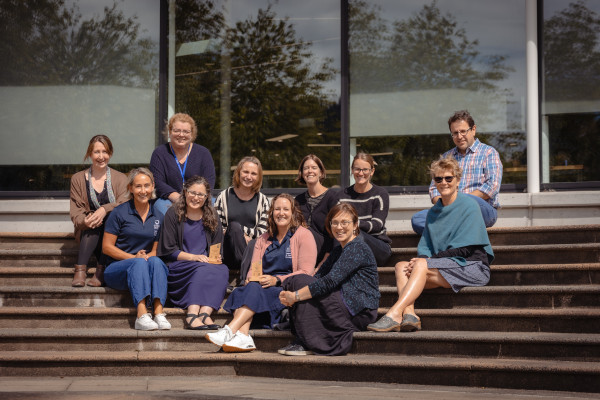- Tūhono home Hoki ki Tūhono
-
- Staff Directory
- Chief Executive Office Auckland International Office Corporate Services Finance Campus Services Functions and Catering Information Systems and Support Marketing, Communications and Engagement Learner Journey Academic Registry International Learner Services Te Punaka Ōwheo
- Learner Experience Academic Excellence Central Campus College of Community Development and Personal Wellbeing College of Engineering, Construction and Living Sciences College of Health College of Work Based Learning Open Education Resource/OERu Research and Postgraduate Studies Te Maru Pumanawa | College of Creative Practice and Enterprise
- Māori Development and Kaitohutohu Office People, Culture & Safety People and Culture Polykids Te Ama Ako | Learning and Teaching Development Wellbeing and Safety Auckland Staff Directory Executive Office Academic Corporate Services Marketing and Business Development Human Resources Campus Quality and Programme Development
-
 Our people make a better world
Our people make a better world
We build the capabilities of individuals, organisations and communities and help them to realise their potential.
Staff Directory
-
- Tools
- Academic Integrity Declaration Form AIC Applications Dashboard Approved Programmes Approved Programme Fees Centralised Assessement Repository Chemwatch CMS - Tūhono & StudentHub updates Course Evaluation and Surveys CRM Applications CRM customer service hub Delegations policy/process Disability and Neurodiversity Dynamics 365 (CRM) EBS Ontrack EBS Report Email Security Personal Portal Employment Matters / Solarworkplace eTaxi eTV
- Financial Variance Reporting Hidden Disabilities Sunflower programme FCM travel intranet InPlace International entry requirements Knowledgebase articles Learner Capability Learner Support Dashboards Linkedin Learning Log a job with Marketing Login as an applicant Microsoft 365 Moderation App Moodle OP Docs OP Docs - Publishing OP Image Libraries Performance Excellence Portal Product Evaluation Panel
- Policy Library Privacy Programme and Course Design and Development Qualtrics XM RDS Remote Access Support Portal Research Database Robertson Library Staff FAQs about Graduation Status of Programmes Student Hub (Kāpehu demonstration view) Study Abroad info for learners Te Whare (Te Pūkenga intranet) Tūhauora I Wellbeing resources Uniprint Vault Webexpenses Auckland Tools
-
 Vault
Had an accident or near miss?
Log it here
Vault
Had an accident or near miss?
Log it here
-
- Communities
- Community AI Steering Committee Ally Network EBS Community of Interest EdTech Champions Health & Wellbeing Research Internal Evaluation Neurodiversity Professional Team Professoriate Proud@OP Student Support Website Advisory Group Web Champions Working under the Rainbow Project Learner Capability Trade Training Centre
- Committee Academic Committee Animals@OP Diversity and Equity Doctor of Professional Practice Committee Kaunihera Whakahaere - Leadership Council Internal Evaluation Learning & Teaching Leadership Team Library Committee Mental Health and Wellbeing Advisory Group Otago Polytechnic Board of Directors Pastoral Care Code Committee Programme Approvals Committee Research and Postgraduate Committee Research Ethics Committee Staff Subcommittee
- Think Tanks Mātauraka Our learners achieve educational success Pūtea Our financial success Tākata Our people, our team, our community Tiriti Our active commitment as a Treaty partner Tūroa Our commitment to be a sustainable and responsive organisation
-
 Create a community
Create a community
Do you have a community, committee or project that you'd like represented here?
Communities
-
- About OP
- Keep up to date All news All events All notices All blogs Share your info Create a news article Create an event Create a notice Create a blog
- Community and Partnerships Alumni and friends Education Foundation Operational information Academic calendar 2025 Academic calendar 2026 Current vacancies Dunedin campus map Our policies Te Whare (Te Pūkenga intranet) Topical FAQs
- Who we are Commemorative sites Māori Strategic Framework Our history Our strategic priorities Pasifika Strategic Framework (2025-2030) Vision and Values Working for us OP job opportunities Wellbeing Calendar Working at OP
-
New Zealand: 0800 762 786
contact us
International: +64 3 477 3014
Incandescent molecules: An analytical investigation into materiality in contemporary abstract painting
Author: Linda Cook
Supervisors: Ed Hanfling Michael Greaves Graham Fletcher
Cook, L. (2022). Incandescent molecules: An analytical investigation into materiality in contemporary abstract painting. (Master's dissertation, Dunedin School of Art, Otago Polytechnic | Te Pūkenga - New Zealand Institute of Skills and Technology). Research Bank. https://doi.org/10.34074/thes.6007
Abstract
This project began by considering abstract painting across the twentieth century, from Malevich to Nozkowski, and subsequently looked at contemporary New Zealand practice. This analysis secured my work within the genres of neo-casualism and new materiality. New materiality accepts that all matter, whether substance or object, has agency and presence. Materials are full of surprises; I celebrate the messy vitality of uncontrollable materials and rejoice at the random slippage of an edge. Quirky, off kilter, seemingly unrefined forms, are characteristic of neo-casualism. Humour is combined with an anti-heroic style. All these elements have been central to my practice. A curious and unexpected body of work has emerged from blending new materiality and neo-casualism, and synchronising discordant elements with waste materials. In working with raw, unpredictable materials and embracing the random ooze or slip, each painting has developed its own personality. The surface and the edge rise to the fore in this body of work. I use the value and vitality of the edge to enliven the centre of the picture plane. The expansive picture plane begins as a sheet of cardboard. By combining textural surface with carefully chosen colours, the cardboard sheds its humble beginning to become an art object. This is no mean feat. The surface eventuates from layers of sealants, gesso, and paint to which texture is added – straw, hair, paper, whatever is at hand. Onto this, layers of colour and clay are pasted and secured as the paintings are built up. These constructions begin to register as objects which have moved beyond representation and into the realm of real form. This praxis has opened broader discussions for my practice, opening avenues for continued rumination on materiality, rhythms and making.
Keywords
abstract art, painting, materialism, neo-casualism, philosophy of art, painting practices, New Zealand
License
This redacted dissertation is available under a Creative Commons Attribution-NonCommercial-NoDerivatives licence CC BY-NC-ND 4.0 International.

